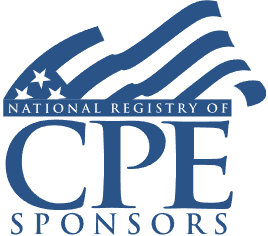Estate Planning for Blended Families: Minimizing Taxes and Estate Issues of Second Marriages

Course Details
- smart_display Format
On-Demand
- signal_cellular_alt Difficulty Level
Intermediate
- work Practice Area
Tax Preparer
- event Date
Wednesday, May 8, 2024
- schedule Time
1:00 p.m. ET./10:00 a.m. PT
- timer Program Length
110 minutes
-
BARBRI is a NASBA CPE sponsor and this 110-minute webinar is accredited for 2.0 CPE credits.
-
BARBRI is an IRS-approved continuing education provider offering certified courses for Enrolled Agents (EA) and Tax Return Preparers (RTRP).
This webinar will review critical trust and estate considerations for blended families. Our panel of knowledgeable inheritance tax professionals will discuss how trusts are used to satisfy certain property transfers, the availability of a DSUE (deceased spousal unused exclusion) after a new marriage, key documents that should be reviewed and updated, and other pertinent issues that need to be addressed for previously married couples.
Faculty

Ms. McCall chairs the Estates, Trusts & Tax Planning practice and is a leading authority on U.S. and international gift and estate planning. She crafts tax-savings business succession and estate transfer plans that preserve wealth and enhance family relationships. Her clients include internationally renowned museums and corporations, charities, foundations, high net worth families and individuals, fiduciaries and nonprofits. Ms. McCall's experience includes complex trust and estate administration and litigation; gift and generation-skipping transfer taxes; spousal rights of election and rights of adopted children; endowments; and tax aspects related to disposition of corporate holdings and financial transactions

Ms. Aghajanian has dedicated her legal career to helping people achieve their family goals as an Estate Planning lawyer at CunninghamLegal. She brings extensive experience designing and drafting wills and trusts, analyzing taxable events, restructuring and consolidating assets, and administering trusts. Ms. Aghajanian is often called upon to create strategies to preserve client assets and design gifting plans to utilize the estate and gift tax exemption. She often helps with planning for Medi-Cal benefits, as well as resolving Medi-Cal estate recovery matters.
Description
Exes and stepchildren are increasingly components of estate plans. Although some planning aspects are the same, there are additional concerns for these families. These may include whether one spouse might disinherit the other's children, children wanting assets before the death of the new or either parent, the need to update estate documents and beneficiaries, and the tax treatment of a former spouse's DSUE.
Couples with prior marriages have varying intentions for asset transfers. Some prefer that each partner leave their respective assets to their children. Other couples want to provide support for the surviving spouse before a transfer, and still others may want an equitable distribution based on current joint assets. The path to resolve these issues can include the use of trusts, new wills, and designated beneficiaries. Tax professionals working with previously married clients need to grasp the tax consequences and additional considerations of family combinations.
Listen as our panel of trust and estate planning experts analyzes specific elements of transfer taxes for couples who were married previously.
Outline
- Estate planning for blended families: introduction
- Probate
- Trusts
- Inherited property and assets
- Wills
- Retirement accounts and IRAs
- Deceased spouse's unused exemption (DSUE)
- Cautionary planning notes for blended families
- Best practices
Benefits
The panel will review these and other critical issues:
- How the DSUE is impacted by a second marriage
- Which documents should be reviewed and updated after a second marriage
- Utilizing trusts to transfer assets for blended families
- Planning suggestions for transferring assets to stepchildren
NASBA Details
Learning Objectives
After completing this course, you will be able to:
- Decide how a DSUE is affected by a second marriage
- Identify ways trusts are utilized to satisfy a couple's transfer wishes
- Ascertain which documents should be reviewed and updated when a taxpayer remarries
- Determine when direct beneficiary designations can aid asset transfers
- Field of Study: Taxes
- Level of Knowledge: Intermediate
- Advance Preparation: None
- Teaching Method: Seminar/Lecture
- Delivery Method: Group-Internet (via computer)
- Attendance Monitoring Method: Attendance is monitored electronically via a participant's PIN and through a series of attendance verification prompts displayed throughout the program
- Prerequisite: Three years+ business or public firm experience preparing complex tax forms and schedules, supervising other preparers or accountants. Specific knowledge and understanding of estate, gift and trust taxation including various trusts types, the unified credit, and portability.

Strafford Publications, Inc. is registered with the National Association of State Boards of Accountancy (NASBA) as a sponsor of continuing professional education on the National Registry of CPE Sponsors. State boards of Accountancy have final authority on the acceptance of individual courses for CPE Credits. Complaints regarding registered sponsons may be submitted to NASBA through its website: www.nasbaregistry.org.

Strafford is an IRS-approved continuing education provider offering certified courses for Enrolled Agents (EA) and Tax Return Preparers (RTRP).
Related Courses

Medicaid Asset Protection Trusts: Technical Overview and Tax Considerations
Available On-Demand

Family Partnerships: Navigating the Discounting Rules for Family-Controlled Entities
Thursday, March 6, 2025
1:00 p.m. ET./10:00 a.m. PT

Form 1041 Schedule D: Reporting Capital Gains for Trusts and Estates
Available On-Demand
Recommended Resources
How CPE Can Bridge the Gap Between What You Know and What You Need to Know
- Career Advancement